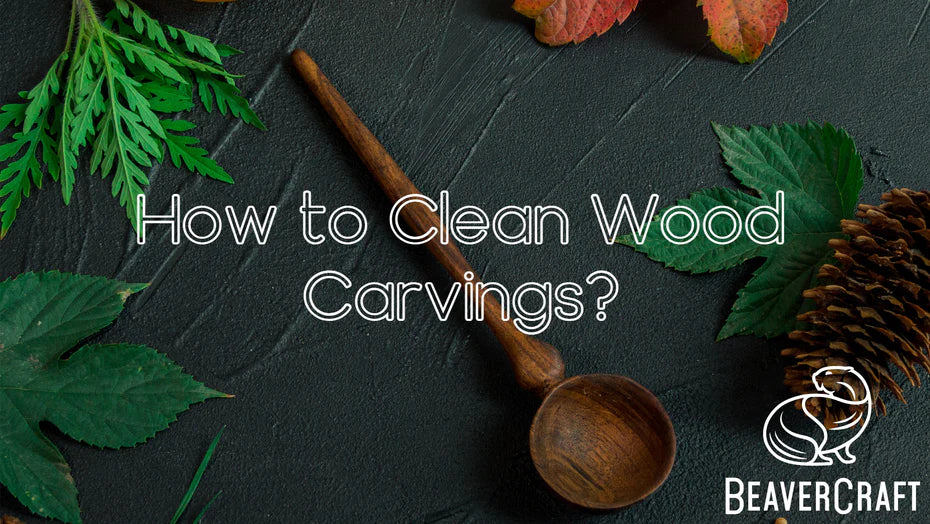How To Keep Your Wood Carvings Clean? Some Useful Tips for You!

Keeping carvings clean might seem not very important but it influences their look quite significantly so if you want your creations to always look new and well maintained, choose the right type of BeaverCraft wooden blanks for your projects and take care of them all the time. Treat them as someone close, make sure they look nice and don’t get damaged by the conditions surrounding them. It is important to note that in order for your wood carving to last a long time you need to initially choose the best wood for wood carving.
And now that the topic has been set, the question you may have is «How do you clean wooden artifacts?» And that’s what we are going to cover in today’s post - how to clean, seal and restore your wooden carvings.
First of all, it’s great to know that you came looking for information first before simply spraying a detergent on wood since that is the first idea that comes into mind when we talk about cleaning something, right? Well, you guessed right: cleaning wood with a simple detergent won’t do. Especially if it’s not covered with finish yet.
Why do wooden statues and wood carvings degrade over time?
Wooden statues and wood carvings are admired for their timeless beauty and intricate craftsmanship. However, as with any organic material, they are subject to natural processes that can lead to degradation over time. Understanding the factors that contribute to the aging and deterioration of these artistic creations is essential for their preservation and proper care. In this article, we will delve into the three main reasons behind the gradual decline of wooden statues and wood carvings, shedding light on how environmental conditions, pests, and maintenance play significant roles in their long-term appearance and durability. By grasping these key aspects, you will be better equipped to protect and cherish these exquisite pieces of art for generations to come.
There are three main causes of wood deterioration:
- Variation in humidity and temperature: Wood is a hygroscopic material, meaning it absorbs moisture. If exposed to a constant high level of moisture, it can swell and even rot. On the other hand, in dry environments, wood gradually shrinks as moisture evaporates, leading to splits, cracks, and deformations. When multiple pieces of wood are assembled, this movement can cause detachment. Sculptures made from a single piece of wood tend to resist better over time. Additionally, temperature and light can alter the color and appearance of wood, contributing to its unique patina and style.
- Proliferation of insects and small rodents: Outdoors, various insects, some of which are wood-eating, pose a threat to statues. Small rodents may also be tempted to gnaw on the wood. In damp, dark, or dirty environments, insects can infest wood and use it as a food source. Regular inspections of statues are crucial, especially checking the back and bottom for signs of infestation. Small holes left on the wood's surface indicate the presence of wood-boring insects, necessitating prompt action to prevent extensive damage.
- Poor maintenance of the wood: Neglecting the maintenance of a wooden statue can lead to a quicker decline in its appearance and durability. Although wood is not a demanding material to care for, regular maintenance is essential. Without proper care, the wood's appearance may become dull over time, weakening its inner structure. Well-maintained wood, however, gains charm and authenticity as it develops a natural patina over the years.
To achieve the elegant patina, follow the cleaning and nourishment tips below and allow time to work its magic on your wooden statue. With proper care, your statue can maintain its beauty and stand the test of time, exuding a distinguished allure similar to ancient wooden sculptures found in museums and private collections.
How to maintain a wood carvings?

We have observed that neglecting wood maintenance is one of the three factors responsible for its degradation. Fortunately, wood maintenance is neither complicated nor arduous. It is crucial to emphasize that using the correct tools and products is of utmost importance for successful wood care. Employing improper tools or harmful products may lead to adverse effects, damaging the appearance of your statue instead of enhancing it.
In brief, the maintenance of a wooden statue involves three essential tasks to be carried out regularly:
|
🔘 Dusting
|
Remove accumulated dust and debris to keep the surface clean and presentable
|
|
🔘 Cleaning
|
Use gentle cleaning methods to remove stains and grime without causing damage to the wood
|
|
🔘 Nourishing the Wood
|
Apply natural wood wax or oil to replenish and protect the wood's appearance and longevity
|
In conclusion, we will explore the steps to repair a damaged wooden statue and also discuss the best practices for displaying a wooden statue in your garden.
Step 1: Wood Cleaning
Over time, dust and various air pollutants accumulate on the wood's surface, hindering its natural beauty. To ensure your wooden statue stays in good condition, we recommend cleaning it approximately twice a year.
When cleaning wood, always opt for natural products like turpentine. This colorless essential oil effectively removes ingrained dirt from the wood's surface. To begin, apply a small amount of turpentine to a soft-bristled brush and gently spread it over the entire statue's surface. Be cautious not to disturb any rough areas of the wood. Afterward, use a soft cloth to blot away any excess turpentine.
Step 2: Wood Nourishment
When your wooden statue starts to lose its luster and the shades fade, it's a sign that it requires nourishment. Typically, this is necessary only once a year, particularly for older sculptures. Avoid overfeeding the wood, as it can be counterproductive and unnecessary.
To revive the wood's natural color and impart a brilliant sheen, we recommend using a natural wax like beeswax.
Waxes provide a beautiful satin finish to the wood and may even enhance its color slightly (except for clear wax). Choose a wax that closely matches your statue's original hue to preserve its authentic appearance.
Caution: If you apply wax over an unfinished wooden statue, it will alter its appearance. The wood's color will darken significantly, and the surface will become more satin-like. If this is not the desired effect, stick to cleaning with turpentine only or ensure that the wax you use is colorless and dull.
Just like dusting and cleaning, use a soft-bristled brush to apply the natural wax in thin layers. After applying the wax, let it set for 10 to 15 minutes. Then, polish your statue by gently rubbing it with a clean, soft cloth (being careful not to catch the wood's edges) to remove any excess wax. This step will reveal the immediate and quite spectacular brilliance and beauty of the wood. In addition to this, it is important to understand how to maintain wood grain to ensure that the entire process from start to finish is nothing but fun for woodcarvers.
How do you clean wooden sculptures?

That, of course, depends on how dirty it is. If you simply want to do a regular light cleaning to keep them looking nice, it should be enough to dust them off with a dry cloth, a soft one, or a feather duster if you have one. For small or very narrow areas where the duster and cloth won’t fit you can grab an old toothbrush with soft hair.
If the carving is dirtier than simple dust, there are several ways to proceed. If that carving is not finished yet but isn’t painted you may take a soft cloth, dampen it with warm water (don’t soak it, just slightly dampen) and slide the cloth across the carving. Don’t rub the moisture in, be very gentle and don’t soak the wood too much. If your carving is painted but not covered with finish, don’t use water or detergent on it because you will damage the paint. In the very best scenario it will faint a little, in the worst it can start cracking or flaking.
When simple water isn’t enough and you need something stronger for cleaning, you can purchase non-toxic wood cleaners (make sure they are safe, especially if you are cleaning wooden spoons or bowls that are used in the kitchen) or make one of your own. Mix together water, olive oil and lemon. That will clean and freshen up the wood.
Sometimes stains are small and can’t be cleaned with water, then you can use sandpaper to grit them away. Here it’s important to be careful but quick to prevent the stains saturating into the wood too much. This is a small guide on«How do you clean wooden sculptures?» topic that will, hopefully, help you to avoid the worst.
Cleaning wood carvings and restoring them - why so important?
Keeping your wooden creations looking clean and fresh does not only influence the way you feel looking at them, but it also affects the quality of the wood itself. If you let it go unmaintained, dirty and dusty it may speed up the negative processes in the wood. And we all want our beauties to live long, so why would we knowingly do that to them?
Restoring carvings is also an important thing to do. You may find an old creation in your attic or at grandma’s house and even enjoy the rustic look of it - trust me, a lot of us do. But it’s needed to polish them up too once in a while. The rustic look won’t go anywhere but keeping the dust and stains off will do them good.
Any carving, old or new, needs to be finished, cleaned and polished from time to time. That’s how you keep enjoying them throughout the years, so don’t neglect this step in your carvings’ treatment and you’ll be golden. That’s our answer to «How do you restore wood carvings and clean them?» question.
What oil do you use for wood carvings?

Choosing a proper finish for the wood you’ve worked on is a thorough job that’s worth previous research and attention in approach. Picking an incorrect finish will shorten the life of your carving in the very best situation and harm your health in the worst (especially if we are talking about finishing various wooden kitchen utensils).
Speaking of which, kitchen utensils such as cups, bowls and spoons require the least chemical option of finish you can find - natural oils. Those are easy to apply, don’t take a lot of time to dry and are safe to use with the thing you’ll be eating from after. It’s not recommended to wash these carved utensils in steaming water or a dishwasher, better to do it carefully with some warm water yourself. You may choose any light natural oil, mostly for carvings linseed oil is used.
With a layered finish, which is a more chemical option, there are some difficulties although they are worth it. Using such a finish is a must if you’re doing outside projects that will stand under different weather all year long or some big pieces of furniture that need to be preserved monumentally. The problem is the chemicals, of course. They are not safe so you have to work in a mask, better to do it outside or get the kids and animals out of the house, at least. Have the room ventilated well and don’t forget that it’s called a layered finish because you have to apply a few layers that take a while to dry each. Some of the layered finishes change the wood color slightly so pay attention to that when you choose them.
Hopefully this answered your question «What oil do you use for wood carving?» together with all the rest. Be attentive, take care and have fun carving!
How To Keep Your Wood Carvings Clean FAQ
How often should I clean my wood carvings?
It is recommended to clean your wood carvings at least once every few months, depending on their exposure to dust and environmental factors. Regular cleaning helps maintain their appearance and prevents dirt buildup.
What is the best method to dust wood carvings?
To dust wood carvings effectively, use a soft, clean cloth or a soft-bristled brush. Gently wipe or brush away the dust, making sure not to apply excessive pressure that might damage the delicate carvings.
How can I remove stains or grime from my wood carvings?
To remove stains or grime from wood carvings, create a mixture of mild soap and water. Dampen a soft cloth with the solution and gently wipe the affected areas. Avoid using harsh chemicals or abrasive cleaners, as they may damage the wood's finish.
Should I apply any products to protect my wood carvings after cleaning?
Yes, after cleaning, it is advisable to apply a thin layer of natural wood wax or oil to protect and nourish the wood. Beeswax or mineral oil are excellent options. Apply the product in small amounts using a soft cloth and buff gently for a protective, beautiful finish.
Author:

Roman Law
Wood carving guruFrom a childhood enchanted by nature, my passion for wood carving guided me on a path of creativity. With a pocket knife, I uncovered the transformative power of my hands, breathing life into driftwood and forging a lifelong connection with the medium.

